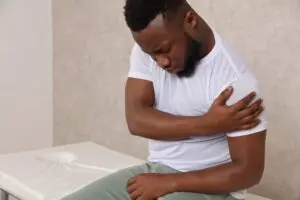What is shoulder bursitis and how can I treat it? There are 150 bursae in our bodies. They are very thin tissue-like sacs filled with fluid that help to cushion areas where there can be friction, like our elbow, knee, and shoulder. They help to prevent irritation between tendons and bones, and ligaments and bones. If there is too much friction in the shoulder, the bursa can become irritated or inflamed causing painful shoulder bursitis.
Symptoms and Types of Bursitis
There are three kinds of bursitis. All have varying symptoms and severity.
Chronic Bursitis
Chronic bursitis occurs over time from repetitive irritation. It usually occurs without any apparent reason, and these continuing flare-ups can damage the bursa causing mobility issues. It can be associated with people who have diabetes, gout, rheumatoid arthritis, and uremia.
Typical symptoms of chronic bursitis is swelling, but it is rarely painful. However, it can feel warm to the touch and mildly painful.
Infected Bursitis
Infected bursitis is the most serious form. Bacteria grows in the bursa sac causing sepsis which may spread to other areas of the body becoming life-threatening.
Tenderness, warmth at the site, and pain are the most typical symptoms of infected bursitis. In addition, the redness and swelling may move down the arm. Most patients with infected bursitis feel sick and feverish. You should see Dr. Koo at our office in Kirkland, WA as soon as possible if you have these symptoms.
Traumatic Bursitis
Traumatic bursitis usually happens to athletes who hit their shoulder or other joints on a hard surface. Immediate swelling occurs and bruises may appear.
Treatments For Shoulder Bursitis
There are a number of things you can do at home.
They include the following:
- Rest the shoulder by modifying your activities
- Ice the shoulder
- Take over-the-counter non-steroidal anti-inflammatory medications for pain and swelling
If these at-home treatments do not relieve the pain, additional treatments are available.
Dr. Koo may recommend the following:
- Use of a splint to immobilize the shoulder
- Stronger prescription medication
- Steroid injections
- Corticosteroid medications for inflammation
- Physical therapy
- Antibiotics if there is an infection
- Aspiration of fluid
Surgery is only recommended if you continue to experience pain and swelling for 6 months to one year.
Contact shoulder surgeon Samuel Koo, MD, MPH at (425) 823-4000 if you are experiencing a swollen or painful shoulder or if you need help preventing future shoulder bursitis.




